Ancient Islands
Have you ever wondered where the word sardonic (“laughter in the face of evil or death”) comes from? There are at least three theories about the etymology of this word, and they all involve the Mediterranean island of Sardinia:
- In pre-Roman times, it was customary in Sardinia to drug old people using a neurotoxic plant and then to push them off a high cliff, laughing loudly while doing so.
- There was a belief that ingesting the sardonion plant from Sardinia would result in convulsions resembling laughter and, ultimately, death.
- While the Romans ruled Sardinia and Corsica for 694 years, slaves captured from Sardinia had a reputation for taking pleasure in killing their masters. The proverb Sardi venales (“Sardinian slaves for cheap”) was a common Latin expression to indicate anything cheap and worthless.
I’ve just had a wonderful trip to Sardinia and Corsica. These two islands are fabulously scenic, the food’s great, and the people are happy, relaxed and hospitable. There was plenty of laughter — and no one tried to kill me!
Getting to these two islands from France or Italy is easy. There are at least five ferry companies that serve these two islands. I took a Grimaldi ferry from Livorno to Olbia (9 hours), a Moby ferry between the north end of Sardinia and the south end of Corsica (1 hour), and a Corsica ferry from Bastia back to Livorno (4.5 hours).
In contrast to ancient traditions of throwing old people off cliffs, Sardinians (and Corsicans) are known for living a long time. Per capita, Sardinia has 10 times more centenarians than the United States. Why? Maybe it’s because of the exercise everyone gets from hiking up and down steep hills. Perhaps their longevity is due to a Mediterranean diet with lots of olive oil. The true secret, I’m told, is a local wine called Cannonau having high levels of antioxidants, anthocyanins, flavonoids and polyphenols which prevent heart disease, dementia and cancer. Sounds good to me. It was delicious!
Crossing the Tyrrhenian Sea, the first island I saw was Elba. This is where Napoleon was temporarily exiled in 1814. With calm seas, warm sunny weather and few cars or people on my ship, I knew I’d made the right decision to come here in October when the weather is good, the water is still warm and most of the tourists have gone home.
My ferry docked in Olbia, an ancient port that dates back to Phoenician times. The old city is a maze of cobblestone streets filled with cafes, restaurants, museums, an antique carousel and the medieval Basilica of San Simplicio. I was traveling with a car, which I would be glad to have later. In Olbia, as in other ancient Italian cities, finding someplace to park for the night was a challenge.
After a night in Olbia, I headed north to explore the real beauty of Sardinia — its dramatic coastlines and crystal blue waters.
On the north coast of Sardinia, I stayed at a fantastic AirBnB overlooking the city of Palau. As I ate my breakfast each morning, I watched the ferries glide back and forth between Palau and the archipelago of La Maddalena.
Some of the unique oddities that draw people to Sardinia are the mystical megaliths carved during the Bronze Age (10,000 years ago) known as Nuraghes. These pre-historic carved rocks are reported to have spiritual powers and the ability to cure people of ailments, aches and pains. Shown here is one of the enthusiasts of these magic rocks receiving the palliative energy of Li MIzzani.
The north coast of Sardinia is a jumble of granite cliffs and outcrops interspersed with protected inlets. October might not be your idea of the perfect time to go to the beach, but this year it was. Anyone who could scramble down through the weathered boulders was rewarded with a private beach and clear, warm water.
At the end of a day of hiking and swimming, I retired to the restaurants in Palau for fresh fish and a glass or two of Cannonau. All summer long, Sardinia is overrun with tourists and the restaurants are packed. By October the tourists are gone, but the restaurants are still open for several more weeks. Reservations aren’t required and the staff will be glad to see you. I enjoyed the personal service one gets when one is the only customer.
Here’s the lighthouse on Capo Testa at the north end of Sardinia. In the distance, you can see Corsica, just 11 kilometers to the north. I was sorry to have only three days to explore this fabulous island. Two weeks would’ve been better. I plan to come back here someday. Anyone want to join me? Bring hiking shoes and a bathing suit.
The Moby ferry took me across the Bocche di Bonifacio. Approaching the south end of Corsica, I was awed by precipitous limestone cliffs, sculpted into bizarre shapes by the sea. The ancient city of Bonifacio sits on top of these cliffs, built here for the strategic advantage of protection against invading navies, of which there have been many: The Carthaginians, Greeks, Etruscans, Romans, Vandals, Ostrogoths, Byzantines, Saracens, Franks, Moors, Pisans, Genoese, British and finally French. This spectacular and romantic city doesn’t need to protect itself today. It opens its arms to invading tourists every summer.
Here’s the ferry coming into Bonifacio on a calm day in October. Beautiful!
I hiked the tops of the cliffs to photograph the city perched high above the sea below.
The ferry enters a sheltered port beneath the old city. The marina is full of yachts.
The old city dates back to Roman times. Inside the fortress walls, the streets are wide enough to accommodate a donkey cart. Today, the city is packed with shops and restaurants.
Not far away are clean, sandy beaches with crystal clear water. High concentrations of calcium ions keep the water clear. I was impressed by how warm the water was in October.
Of course, Corsica is France. So, it’s no surprise to see gentlemen playing Pétanque outside the train station in Bastia.
From Bastia, I took a ferry back to Italy. This was the end of my six day tour of these two islands. Too brief! I’ll have to come back now that I know how easy it is to get here. And when I come back, it’ll be in October!

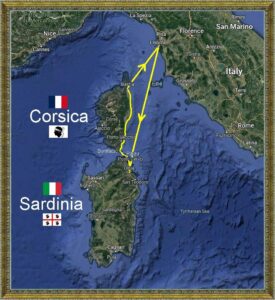

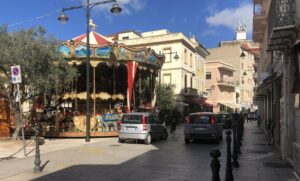
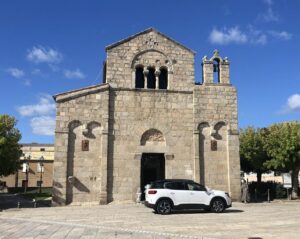


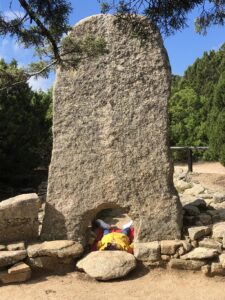

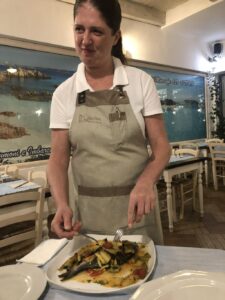



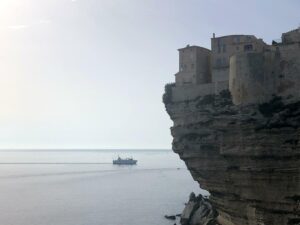




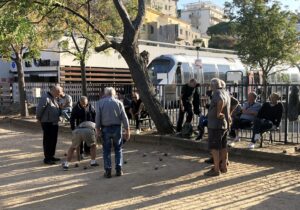
Enjoyed the fotos. Keep on truckin’.
Wow, Sardinia! I’ve been there about 10 years ago also only for a long weekend and remember it quite similar to your descriptions. It was very cheap and easy to fly over from my hometown which was one of the reasons we chose it in the first place. But then I was also like “have to come back” – now, we’ll definitely keep it in mind for one of the next vacations.
Maybe in October… 😉
Hi Nick,
Wow…I feel like I just took that trip myself. I really was transported there through your vivid descriptions and accompanying photos. I always learn so much about your travel destinations. How enchanting these two islands must have been. Wonderful blog. Keep them coming.
Sending you warm wishes for safe and happy days.
Ingrid
I never knew the derivation of “sardonic”–what a wonderful story!
The pictures and descriptions are fabulous, too.
So glad you went there! I had a vague plan to do the same this October, maybe next? My grandfather’s family came from there to Florida in the early 1600s.